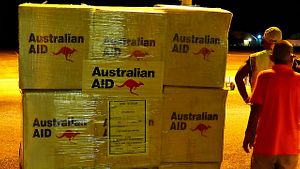Australia’s aid program turned 40 in 2014. But there was little cause for celebration. Earlier this month – and for the third time since coming to office – the Abbott Government slashed the aid budget. This time on an unprecedented scale.
In fact, once these cuts are fully implemented, Australia will be giving a paltry 22 cents in foreign aid for every $100 dollars of its gross national income, the least Australia has given in 40 years. And to say these cuts are disproportionate would be an understatement. The aid budget currently makes up just over 1 percent of Australia’s Federal Budget, yet forms $1 in every $4 of the Government’s total savings. These cuts – and the ease with which they were pushed through – substantiate reports of an ever-growing divide in Australia’s political class, between those who view aid as merely a discretionary expense with some charitable value and those who see it as a necessary strategic investment for fostering stability, security and prosperity.
The problem with the aid-as-charity camp, populated by the Treasurer Joe Hockey and Prime Minister Abbott, is that it belies the fact that Australia is one of the most interconnected nations in the world. In their isolationist conception of Australia, the benefits of aid flow just one-way: out. As such, it is something done during the good days, when loose change is aplenty. And then when the sun sets on the boom times, charity must come to an end. The money should be repurposed and spent in Australia’s “own backyard.”
In contrast, those who subscribe to the aid-as-a-necessary-strategic-investment view, like Australia’s Foreign Minister, Julie Bishop, see the benefits of aid as a two way street – “an investment in the future of our region” to quote Bishop.
Recently launching an exhibition to mark 40 years of Australian aid giving, Bishop was at pains to outline what aid has been able to do – and what it could do – for Australia and the Indo-Pacific region. In her address, Bishop reflected on what she considered to be some “powerful examples” of Australia’s development achievements, including its support for the Thai-Lao Friendship Bridge, opened in 1994. As of 2013, 6 million people now cross the bridge annually, enabling trade of goods and services with total annual revenue standing at nearly 60 billion baht. Commerce likes this leads to increased economic growth and rising living standards, in turn fueling consumption of goods and services from countries like Australia. Perhaps unsurprisingly, Thailand has gone from being an aid recipient to one of Australia’s top trading partners – as have other countries in the region like China and Malaysia.
Another case study of how aid – as a strategic investment – pays off is South Korea. In the aftermath of the Korean War, South Korea was one of the poorest countries in the world – even North Korea had higher living standards. With long-term thinking, the United States and its allies contributed to South Korea’s reconstruction, helping to create the takeoff conditions for the Miracle on the Han River.
Decades later, the benefits of these investments speak for themselves. South Korea has now become an aid donor itself and is investing in regional poverty reduction, peace and security. And for Australia, South Korea has become its third largest export market with total two way trade worth over A$30 billion ($24.6 billion) a year; and the Korea-Australia Free Trade Agreement is expected to create 1000 new Australian jobs in its first year alone.
Although the role of smart aid as a factor in producing such long-term payoffs is not widely acknowledged across the Abbott Government, Julie Bishop at least seems to appreciate this. As she recently said:
“40 years of aid is a measure of national character. It is a measure of our aspirations for ourselves –as leaders, as ‘doers’, as a Top 20 nation making a significant contribution to the world and it’s the quality of our spend that is important – careful, considered investments in the peace and prosperity of our region.”
Maybe its time the rest of the Government, the treasurer and prime minister included, started listening to their foreign minister on foreign policy.
Michael Sheldrick is currently the Head of Global Policy and Advocacy with the New York-based Global Poverty Project and is a former Young Western Australian of the Year Follow him on Twitter @micksheldrick. Akram Azimi was 2013 Young Australian of the Year. He is co-founder of the “I am the Other” group and has been an active commentator on Australian public policy. Follow him on Twitter @AkramAzimi.

































